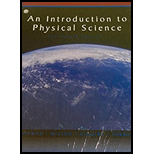
INTRO.TO PHYSICAL SCIENCE NSU PKG >IC<
14th Edition
ISBN: 9781305765443
Author: Shipman
Publisher: CENGAGE C
expand_more
expand_more
format_list_bulleted
Concept explainers
Question
Chapter 21, Problem 15SA
To determine
The plate which is subducted during the collision of the oceanic plate with continental plate at a convergent boundary.
Expert Solution & Answer
Want to see the full answer?
Check out a sample textbook solution
Students have asked these similar questions
The cylindrical beam of a 12.7-mW laser is 0.920 cm in diameter. What is the rms value of the electric field?
V/m
Consider a rubber rod that has been rubbed with fur to give the rod a net negative charge, and a glass rod that has been rubbed with silk to give it a net positive charge. After being charged by contact by the fur and silk...?
a. Both rods have less mass
b. the rubber rod has more mass and the glass rod has less mass
c. both rods have more mass
d. the masses of both rods are unchanged
e. the rubber rod has less mass and the glass rod has mroe mass
8) 9)
Chapter 21 Solutions
INTRO.TO PHYSICAL SCIENCE NSU PKG >IC<
Ch. 21.1 - What are the four regions of the Earths interior?Ch. 21.1 - Prob. 2PQCh. 21.2 - Prob. 1PQCh. 21.2 - Prob. 2PQCh. 21.3 - Prob. 1PQCh. 21.3 - Prob. 2PQCh. 21.4 - Prob. 1PQCh. 21.4 - Prob. 2PQCh. 21.5 - Prob. 1PQCh. 21.5 - On what crustal plate is Los Angeles located, and...
Ch. 21.6 - Prob. 1PQCh. 21.6 - Prob. 2PQCh. 21 - Prob. AMCh. 21 - Prob. BMCh. 21 - Prob. CMCh. 21 - Prob. DMCh. 21 - Prob. EMCh. 21 - Prob. FMCh. 21 - Prob. GMCh. 21 - Prob. HMCh. 21 - Prob. IMCh. 21 - Prob. JMCh. 21 - Prob. KMCh. 21 - Prob. LMCh. 21 - Prob. MMCh. 21 - Prob. NMCh. 21 - Prob. OMCh. 21 - Prob. PMCh. 21 - Prob. QMCh. 21 - Prob. RMCh. 21 - Prob. SMCh. 21 - Prob. TMCh. 21 - Prob. UMCh. 21 - Prob. VMCh. 21 - Prob. WMCh. 21 - Prob. XMCh. 21 - Prob. YMCh. 21 - Prob. ZMCh. 21 - Prob. AAMCh. 21 - Prob. BBMCh. 21 - Prob. 1MCCh. 21 - The Moho boundary separates which two layers of...Ch. 21 - Prob. 3MCCh. 21 - Which of the following geologic evidence does not...Ch. 21 - Prob. 5MCCh. 21 - Which of the following is a primary cause of...Ch. 21 - Prob. 7MCCh. 21 - Prob. 8MCCh. 21 - What process during plate collisions leads to the...Ch. 21 - On the Richter scale, a magnitude 7.0 earthquake...Ch. 21 - Prob. 11MCCh. 21 - Prob. 12MCCh. 21 - Prob. 1FIBCh. 21 - Prob. 2FIBCh. 21 - Prob. 3FIBCh. 21 - Prob. 4FIBCh. 21 - Prob. 5FIBCh. 21 - Prob. 6FIBCh. 21 - Prob. 7FIBCh. 21 - Prob. 8FIBCh. 21 - Dubbed the ___, it is the geologically active...Ch. 21 - Prob. 10FIBCh. 21 - Prob. 11FIBCh. 21 - Prob. 12FIBCh. 21 - Prob. 1SACh. 21 - Name the four major regions of the Earth, from...Ch. 21 - Prob. 3SACh. 21 - Prob. 4SACh. 21 - Explain the mechanism behind continental drift.Ch. 21 - What is the Mid-Atlantic Ridge?Ch. 21 - Prob. 7SACh. 21 - Prob. 8SACh. 21 - Prob. 9SACh. 21 - Prob. 10SACh. 21 - Explain how continental crust and oceanic crust...Ch. 21 - Prob. 12SACh. 21 - Prob. 13SACh. 21 - Prob. 14SACh. 21 - Prob. 15SACh. 21 - Prob. 16SACh. 21 - Prob. 17SACh. 21 - Prob. 18SACh. 21 - Prob. 19SACh. 21 - Prob. 20SACh. 21 - Prob. 21SACh. 21 - Prob. 22SACh. 21 - Prob. 23SACh. 21 - Prob. 24SACh. 21 - Prob. 25SACh. 21 - Distinguish among a normal fault, a reverse fault,...Ch. 21 - Prob. 27SACh. 21 - Prob. 28SACh. 21 - Prob. 1VCCh. 21 - State two similarities between the methods used by...Ch. 21 - Prob. 2AYKCh. 21 - Describe an accurate method to measure the...Ch. 21 - Prob. 4AYKCh. 21 - Prob. 5AYKCh. 21 - Refer to Fig. 21.16 and 21.19. In terms of...Ch. 21 - What forces and factors determine whether a rock...
Knowledge Booster
Learn more about
Need a deep-dive on the concept behind this application? Look no further. Learn more about this topic, physics and related others by exploring similar questions and additional content below.Similar questions
- Lab 8 Part 3 PHET Wave Interface simulation. I am having trouble with this part of the lab.arrow_forwardMick and Rick are twins born on Earth in the year 2175. Rick grows up to be an Earth-bound robotics technician while Mick becomes an intergalactic astronaut. Mick leaves the Earth on his first space mission in the year 2200 and travels, according to his clock, for 10 years at a speed of 0.75c. Unfortunately, at this point in his journey, the structure of his ship undergoes mechanical breakdown and the ship explodes. How old is Rick when his brother dies?arrow_forwardHi, I have canceled, why did you charge me again?arrow_forward
arrow_back_ios
SEE MORE QUESTIONS
arrow_forward_ios
Recommended textbooks for you
 An Introduction to Physical SciencePhysicsISBN:9781305079137Author:James Shipman, Jerry D. Wilson, Charles A. Higgins, Omar TorresPublisher:Cengage Learning
An Introduction to Physical SciencePhysicsISBN:9781305079137Author:James Shipman, Jerry D. Wilson, Charles A. Higgins, Omar TorresPublisher:Cengage Learning AstronomyPhysicsISBN:9781938168284Author:Andrew Fraknoi; David Morrison; Sidney C. WolffPublisher:OpenStax
AstronomyPhysicsISBN:9781938168284Author:Andrew Fraknoi; David Morrison; Sidney C. WolffPublisher:OpenStax Foundations of Astronomy (MindTap Course List)PhysicsISBN:9781337399920Author:Michael A. Seeds, Dana BackmanPublisher:Cengage Learning
Foundations of Astronomy (MindTap Course List)PhysicsISBN:9781337399920Author:Michael A. Seeds, Dana BackmanPublisher:Cengage Learning

An Introduction to Physical Science
Physics
ISBN:9781305079137
Author:James Shipman, Jerry D. Wilson, Charles A. Higgins, Omar Torres
Publisher:Cengage Learning

Astronomy
Physics
ISBN:9781938168284
Author:Andrew Fraknoi; David Morrison; Sidney C. Wolff
Publisher:OpenStax

Foundations of Astronomy (MindTap Course List)
Physics
ISBN:9781337399920
Author:Michael A. Seeds, Dana Backman
Publisher:Cengage Learning

A Level Physics – Ideal Gas Equation; Author: Atomi;https://www.youtube.com/watch?v=k0EFrmah7h0;License: Standard YouTube License, CC-BY